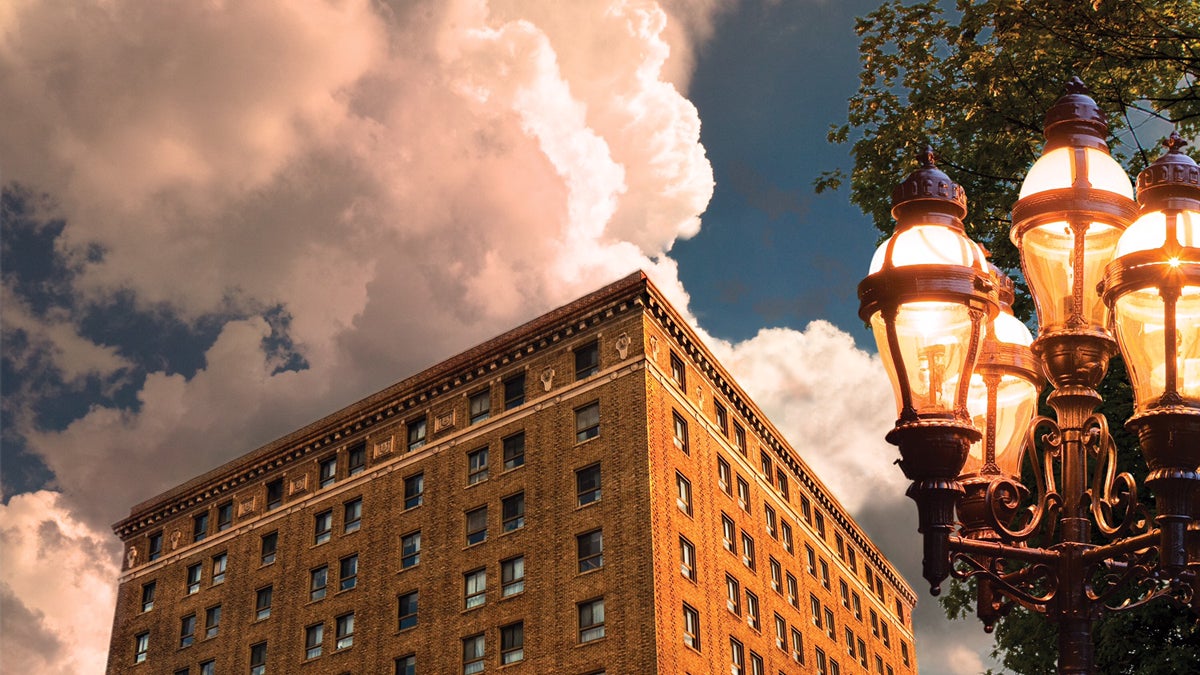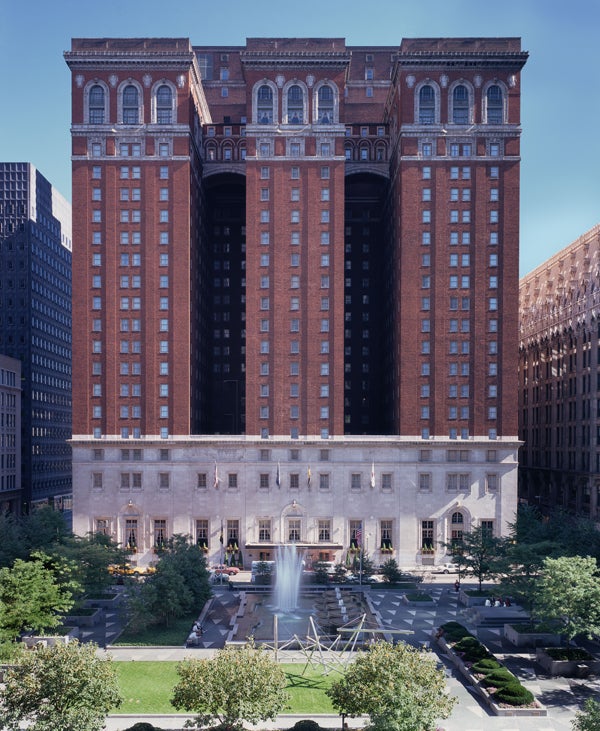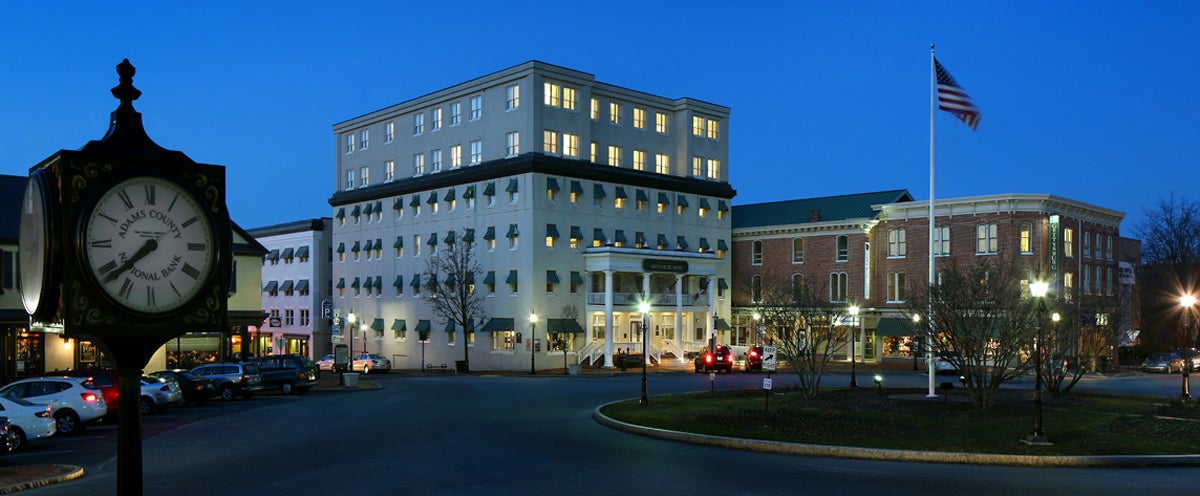The challenges of preserving historic hotels of Pennsylvania

The Hotel Bethlehem was built in 1922 at the encouragement of the Bethlehem Steel company to accommodate special guests to the city. (Image courtesy of Hotel Bethlehem)
The hotel industry is enjoying a boom time in Philadelphia.
New accommodations are under construction in what will be the city’s tallest office tower, the Comcast Innovation & Technology Center; in what will be the state’s highest residential building, the SLS building; and at other sites on the Penn and Drexel campuses, in Center City, and in Fishtown.
Some of the new hotels will adapt historic spaces, including the Family Court, Liberty Title and Trust, and the Willis Hale Building at Juniper and Chestnut Streets.
But few hospitality companies and contemporary chains are willing to take on the preservation and maintenance of historic hotel buildings — those inns that hosted famous guests for decades and catered to generations of travelers.
The old hotels often pose too many challenges due to their original designs, the expense of updating, and the expectations of most contemporary visitors.
Yet those who seek the character of a grand old lobby and elegant rooms can still find well-preserved historic hotels along the byways of Pennsylvania. They may not be exactly the way our grandparents found them, but they do retain the charm and singular experience of an earlier age.
Location and accommodation
The demise of many older hotels in this region and throughout the U.S. often had to do with their location, explained Mindy Crawford, executive director of Preservation Pennsylvania, the commonwealth’s private, nonprofit organization dedicated to protecting historic resources.
Early hotels were often built in a city’s downtown, in the center of population and commerce. With the rise of car culture in the 1950s and ’60s, roadside inns and motels became the stopovers for Americans on the go. “They were looking for cheap hotels near the interstate — places to change and eat. You had no idea of the quality of a place, so you looked for familiar brands,” like Howard Johnson’s and Holiday Inn, Crawford said.
To draw visitors downtown now, cities must offer special events, attractions and a vibrant shopping and restaurant district. “You have to have the market — some reason to come into the city and stay in a historic building,” Crawford said.
The hotels erected in earlier centuries also were designed to accommodate as many guests as possible. The rooms were small and guests usually shared a bathroom. Updating a historic hotel begins with knocking down walls and creating suites and larger standard rooms. Other renovations must follow: installing fire sprinklers, adding access for disabled guests, and addressing other safety issues. Equally important in the 21st century are access to WiFi, business centers, gyms, and other amenities.
“Keeping a hotel as a hotel requires a lot of change,” Crawford said. More often, a downtown hotel developer will choose to repurpose an old mill or factory, “where they’re starting with a blank canvas.”
Crawford, of course, sees the advantages of staying in a long-established, well-appointed older hotel. “I prefer the idea of walking into a hotel with a grand lobby, comfy seats, beautiful rugs, and even a fountain sometimes. When you travel, it can be hard to be on the road, and some people like staying in a room that could be anywhere. But those places with charm and lovely hallways and furniture — there’s something special about them.”
A Western Pennsylvania legend
When she’s in Pittsburgh, Mindy Crawford likes to stay in the Omni William Penn, which is owned by one of the contemporary chains that has found success in preserving landmark hotels.

The William Penn Hotel in Pittsburgh was built in 1916, and expanded to 1,600 rooms in 1928, making it the largest hotel at the time from New York to Chicago. (Image courtesy of the William Penn Hotel)
In March, the William Penn will celebrate its centennial and a very colorful history. Completed at a cost of $6 million in 1916, the hotel had 1,000 rooms and occupied one million square feet over a city block. “Trying to maintain that size space has never been easy,” said Bob Page, director of sales and marketing.
The hotel opened when Pittsburgh was the capital of the steel industry, and it was intended to cater to titans of industry. But from the start, it relied more on visits from conventioneers and traveling salesmen to fill its rooms.
Designed by the firm of Janssen & Abbott, the hotel was built in the Italianate style, with creamy terra cotta on the lower floors and three brick and steel towers rising above. “It was a very lavish hotel and way ahead of its time,” Page said. That meant private baths in each room and ice machines, an opulent lobby of green Italian marble floors and ornate ceiling, and a Renaissance-style ballroom with gilt molding and crystal chandeliers.
Celebrity guests in the early years included entertainment luminaries Mary Pickford and Flo Ziegfeld. Business was so good that the hotel added 600 rooms in 1928, making it the largest hotel between New York and Chicago.
Bandleader Lawrence Welk was a newcomer to Pittsburgh when he played the hotel on New Year’s Eve 1938 and became a regular performer there. Nearly a decade later, Welk returned to the hotel and was introduced to a bubble machine, created for a banquet honoring director Cecil B. DeMille. Welk adopted the bubble-maker for his trademark “Champagne Music.” The original bubble machine remains a beloved artifact on display at the William Penn.
But it wasn’t all bubbly for the hotel by mid-century. In the 1960s, occupancy declined significantly. The Sheraton chain, then the owner, announced plans to sell the building to developer John Galbraith, and there were rumors it would be razed. The Hotel and Restaurant Employees Union warned that new owners would have to assume the three-year contract for its workers. Galbraith withdrew and Sheraton retained ownership.
A few years later the union insisted on a contract clause that the hotel would not be sold except as a hotel, and the Sheraton refused. A strike followed, the hotel closed to all but its permanent guests, and the Sheraton company left the city.
Various owners came and went, and the William Penn suffered through face lifts and modernization. Alcoa took over the hotel in 1971. A $30 million restoration began in 1984, which included gutting and rebuilding guest floors, replacing plumbing and electrical systems, and refurbishing the Grand Ballroom and lobby.
In 2001, Omni purchased the William Penn and launched a five-year, $20 million renovation that included restoration of the hotel’s façade.
Through all the changes, there has been an effort to retain the hotel’s historic ambiance, Page said. “We’ve always tried to protect the hotel’s integrity from the historic standpoint.”
The William Penn is now the only original hotel building in Pittsburgh that remains a hotel, and “we take great pride in that fact,” Page said.
A room in Bethlehem
“Every American town in its heyday had at least one good center city hotel, someplace to put up the special guests in town,” said Dennis Costello, general manager of the Hotel Bethlehem. “This hotel acted in that capacity.”
The Hotel Bethlehem was built in 1922, after Bethlehem Steel convinced the local Chamber of Commerce to manage the sale of 1,000 bonds at $1,000 each to finance the project.
When it opened, the Hotel Bethlehem was state of the art, Costello said, and in the early decades hosted visits by Amelia Earhart, Henry Ford, Thomas Edison and Winston Churchill. Their photos and those of many other VIPs are found in the hotel taproom. “That’s part of the charm. This hotel is about as far from being cookie-cutter as you can get,” Costello said.
But by the 1960s, the Hotel Bethlehem struggled to maintain its status as the Lehigh Valley’s star hotel. When John F. Kennedy booked rooms during his presidential campaign, the hotel manager had to scour the building to find enough suitable furniture and rugs to make the master suite presentable for the candidate.
Bethlehem Steel came to the rescue in the 1970s, investing in the building and raising it to a four-diamond rating by the early 1980s. When the steel industry sunk into troubles of its own, local business people purchased the hotel. It still closed down in 1998.
Local investors reopened the Hotel Bethlehem a year later and began a series of much needed renovations. The elevators, hot water system and kitchen equipment were replaced. Flatscreen TVs, coffeemakers, and WiFi were added to the rooms. “The hotel has never been as healthy and highly rated as it is now,” Costello said.
And it still maintains the interior design of the original hotel, “which is something you won’t find anywhere,” Costello said. “With most of the modern brands, whether you’re in Boise or Buffalo or Brooklyn, they have all have the same look and feel. Whereas JFK and the Dalai Lama stayed here.”
An American landmark in Gettysburg
One of Pennsylvania’s most historic cities has a hotel with a back story to match. The Gettysburg Hotel sits on the site of the former Scott’s Tavern, established in 1797, and has served as a way station for travelers for centuries.

The Gettysburg Hotel sits on historic Lincoln Square. (Image courtesy of the Gettysburg Hotel)
In the 1860s, both Confederate and Union commanders used the building as headquarters. Across the street in the David Wills House, which still stands, President Lincoln reportedly completed the Gettysburg Address.
The hotel building was renovated in the 1890s and christened the Gettyburg Hotel. In the 1900s, steam heat, hot and cold baths and a restaurant were added to the establishment. In the 1950s, the hotel served as the temporary White House for President Eisenhower, while he recovered from a heart attack.
The next decades were dark chapters. The hotel, like so many other historic inns, closed in the mid-1960s for want of visitors, and then was severely damaged by a fire in 1983.
Through an initiative of Gettysburg College, the hotel was lovingly restored and reopened in 1991. While the original hotel building was lost, the new hotel encompasses several historic buildings in central Gettysburg, explained general manager Chuck Moran. A neighboring bank that was built during the Civil War now serves as the hotel ballroom, which hosts 40 events per year. The hotel also attracts business leadership conferences that use the nearby battlefield for training exercises.
Visitors particularly enjoy the views from the historic wing of the hotel overlooking Lincoln Square. But the old walls and windows aren’t soundproof, Moran said, and revelers leaving the local taverns sometimes bother the guests — one of the challenges of the older, historic hotels.
“But the fact that they’re right here in Gettysburg is a big attraction,” Moran said, and “the guests just love that we’re on this unique, historic square.”
WHYY is your source for fact-based, in-depth journalism and information. As a nonprofit organization, we rely on financial support from readers like you. Please give today.


